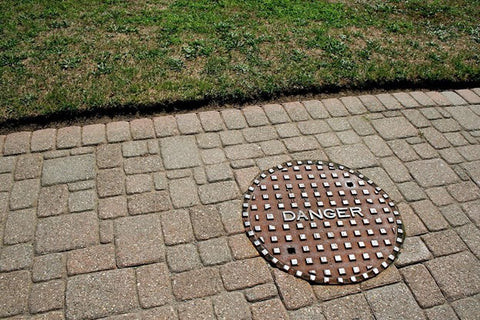Most people are familiar with Sputnik, the first artificial satellite, launched by the Soviet Union in October 1957. However, an intriguing urban legend suggests that Earth’s first foray into sending objects skyward might have happened earlier that year, not with a satellite, but with something far more mundane: a manhole cover.
While typical manhole covers safeguard city dwellers from open utility access points, the manhole cover in this story had a different purpose. This wasn’t about keeping things out; it was about containing something incredibly powerful in.
It seems unbelievable that a simple manhole cover could be launched into space without advanced machinery. Yet, a partially miscalculated nuclear experiment in the 1950s hints at the possibility that this extraordinary event might have actually occurred.
Manhole covers rarely capture global attention, but the notion of one being propelled into space captured imaginations worldwide. Let’s delve into the story of one of history’s most remarkable—and accidental—scientific events, and try to answer the question: How Fast Did The Manhole Cover Fly?
The Genesis of Operation Plumbob
In the months leading up to Sputnik’s launch, the United States was actively engaged in nuclear testing through Operation Plumbob. This series of 29 tests, conducted at the Los Alamos Scientific Laboratory between May and October 1957, shifted towards underground detonations by July.
This move to underground testing was motivated by a desire to shield nearby populations from atmospheric radioactive fallout. For the inaugural underground test, a shaft, 4 feet in diameter and 500 feet deep, was excavated. The plan was to seal the shaft with a five-foot thick concrete cap to contain the anticipated explosion.
However, the Pascal-A test, as it became known, yielded a force 50,000 times greater than initially predicted. This colossal blast obliterated the round concrete cap and vented significant amounts of radioactive material 100 feet into the atmosphere. Despite the containment failure, the scientists learned valuable lessons for subsequent tests.
August saw preparations for Pascal-B, the next underground nuclear experiment. This time, a 400-foot shaft was drilled, housing a nuclear device at its base. Dr. Robert Brownlee was tasked with designing a robust concrete manhole cover, weighing half a ton, intended to withstand the blast. Despite Dr. Brownlee’s calculations suggesting the experiment’s containment might fail, the test proceeded as planned.
As Dr. Brownlee foresaw, the Pascal-B detonation instantly vaporized the concrete manhole cover, generating immense pressure beneath the remaining cap structure. Unable to contain the explosion, the cap was violently ejected upwards at an astonishing velocity. Once again, radioactive gases escaped, and the fate of the now-famous manhole cover became an enduring mystery.
 A sturdy concrete manhole cover, similar to the type used in the Pascal-B nuclear test, highlighting the object that was launched at incredible speed.
A sturdy concrete manhole cover, similar to the type used in the Pascal-B nuclear test, highlighting the object that was launched at incredible speed.
The Unbelievable Velocity: How Fast Did It Really Fly?
While definitive proof of its cosmic journey is absent, many scientists believe the manhole cover from the Pascal-B experiment holds the distinction of being the fastest human-made object. But just how fast did the manhole cover fly?
Dr. Brownlee’s calculations estimated the manhole cover launched at an incredible speed of over 37 miles per second, translating to approximately 130,000 miles per hour. He described this mind-boggling speed as “more than five times the escape velocity of the planet.” Escape velocity is the speed needed to break free from Earth’s gravitational pull and venture into space.
To grasp the sheer speed, consider the high-speed camera deployed to record the event. Capturing images at a rate of one frame per millisecond, the camera only registered the manhole cover in a single frame. In the blink of an eye – or rather, in a millisecond – it was gone.
Despite this phenomenal launch, the question lingers: surely, what goes up must come down? Did the manhole cover eventually return to Earth?
The Manhole Cover’s Mysterious Whereabouts
Even today, the final resting place of the Pascal-B manhole cover remains unknown, baffling scientists and fueling speculation. The most captivating theory posits that it was propelled into space, potentially preceding Sputnik as the first human-made object to reach such heights.
Initially, there was anticipation that the manhole cover would eventually reappear somewhere on Earth. However, over half a century later, it remains missing. Dr. Brownlee himself admitted uncertainty about its fate, suggesting the intense forces might have caused it to disintegrate before reaching space. Yet, his calculations also left open the tantalizing possibility of a space-bound manhole cover.
The debate about the Pascal-B manhole cover’s location persists. The truth is, we may never definitively know what happened to it after that fateful nuclear test.
The Enduring Enigma of Pascal-B’s Cap
The speculation surrounding the 1957 underground manhole cover nuclear test continues to this day. In the absence of concrete evidence confirming either its spacefaring journey or earthly return, the question of whether the first human-made object in space was Sputnik or a humble manhole cover remains open to interpretation.
Pascal-B’s legacy, however, is clear. It demonstrated the surprising resilience of manhole covers. While ultimately unable to contain the extreme pressures of a nuclear explosion, the fact that it might have been launched into Earth’s orbit stands as a testament to their inherent durability.
If you’re intrigued by the substantial weight of manhole covers, you might find our blog post on why manhole covers are so heavy equally fascinating.
